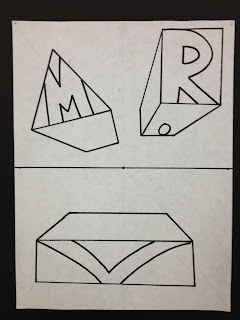Week 1:
One point perspective creates the illusion of 3D form on a flat 2D surface, which plays with our perception of space and depth. There are many steps to this project. First students draw a horizon line in the middle of the page, then add a vanishing point in the center of that time. Next, students add their shapes which takes four steps:
- Draw the shape you want.
- Connect open corners from the shape to the vanishing point.
- Draw parallel lines in each side to close the shape.
- Erase the extra guidelines between the shape and the vanishing point.
During this process students learn the importance of using a ruler to keep all lines straight and clean. We also talk about different types of balance in art. All artwork has some kind of balance. In this project, we want to create even balance. Students ware challenged to make enough shapes to fill in the letters of their name and to balance those shapes to achieve even balance. Students also learn how to make their block or bubble letters "fit" into the shapes.
Week 2-3:
Next, we address the background. We want a pattern in the background to visually separate the 3D shapes from the background, and to make the background interesting to look at. Students begin with some lines to break up the background into an even number of spaces, all intersecting the vanishing point. Then students select whichever shapes they wanted to draw to overlap the background lines. This set up an interesting background that could be colored as a pattern. Once this is done, students trace all these lines with sharpie. We also talk about careers that use one point perspective, such as architects and graphic designers.
Week 4-5:
Finally, students learn about color theory. Warm colors are perceived to come out towards us as viewers and cool colors are perceived to recede away from us as viewers. Obviously, to enhance the optical illusion, students learn to use warm colors in the 3D shapes/letters and cool colors in the patterned background. Using color in this way really helps to visually separate the 3D shapes from the background.







No comments:
Post a Comment